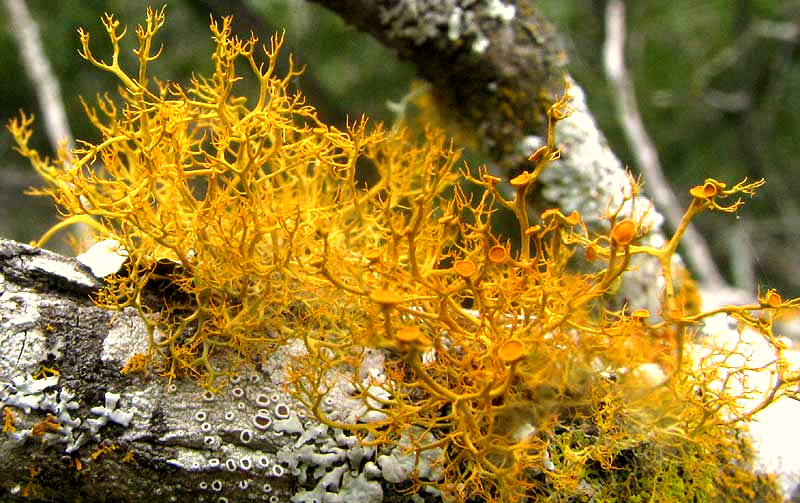Excerpts from Jim Conrad's
Naturalist Newsletter

from the September 9, 2012 Newsletter issued from the valley of the Dry Frio River in northern Uvalde County, southwestern Texas, on the southern border of the Edwards Plateau; elevation ~1750m (~5750 ft); N29.62°, W99.86°; USA
SLENDER ORANGE BUSH LICHEN
On gnarly oak branches often you see the orange fruticose lichen shown above. Having no idea about its identity I did an image search on the keywords "lichen orange tree branches Texas" and that brought up pictures that gave me the name: TELOSCHISTES EXILIS, sometimes called Slender Orange Bush Lichen. It occurs in tropical and subtropical habitats throughout the Americas.
Whenever you see a brightly colored lichen like this one, there's a good bet you can extract dye from it. However, you don't necessarily get the color you're expecting. One study found that using an ammonia extraction method Slender Orange Bush Lichen produced a pink dye that turned slate blue in sunlight. If you extract several times with ammonia you get brown or rose on the first steeping, deep rose on the second steeping, and pink on the third steeping. That study can be accessed at http://www.turkeyredjournal.com/Dean.html.
Several web pages remark that Slender Orange Bush Lichen is disappearing in their area, which suggests that the species is vulnerable to pollution. Happily, the air in our isolated little corner of southwest Texas seems to be very clean.
However, some people here spray their trees to kill the lichens and bromeliads on them. They observe that lichens and bromeliads occur on dead branches, so they reason that the lichens and bromeliads must be killing those branches. Of course it's the other way around: The dead branches offer living space in good light, so lichens and bromeliads cluster there, not on the living branches where leaves produce too much shade for them. Moreover, studies on the matter show that lichens and bromeliads produce nutrients valuable to their host tree. People should be happy to have lichens and bromeliads on their trees, and not spray to kill them.